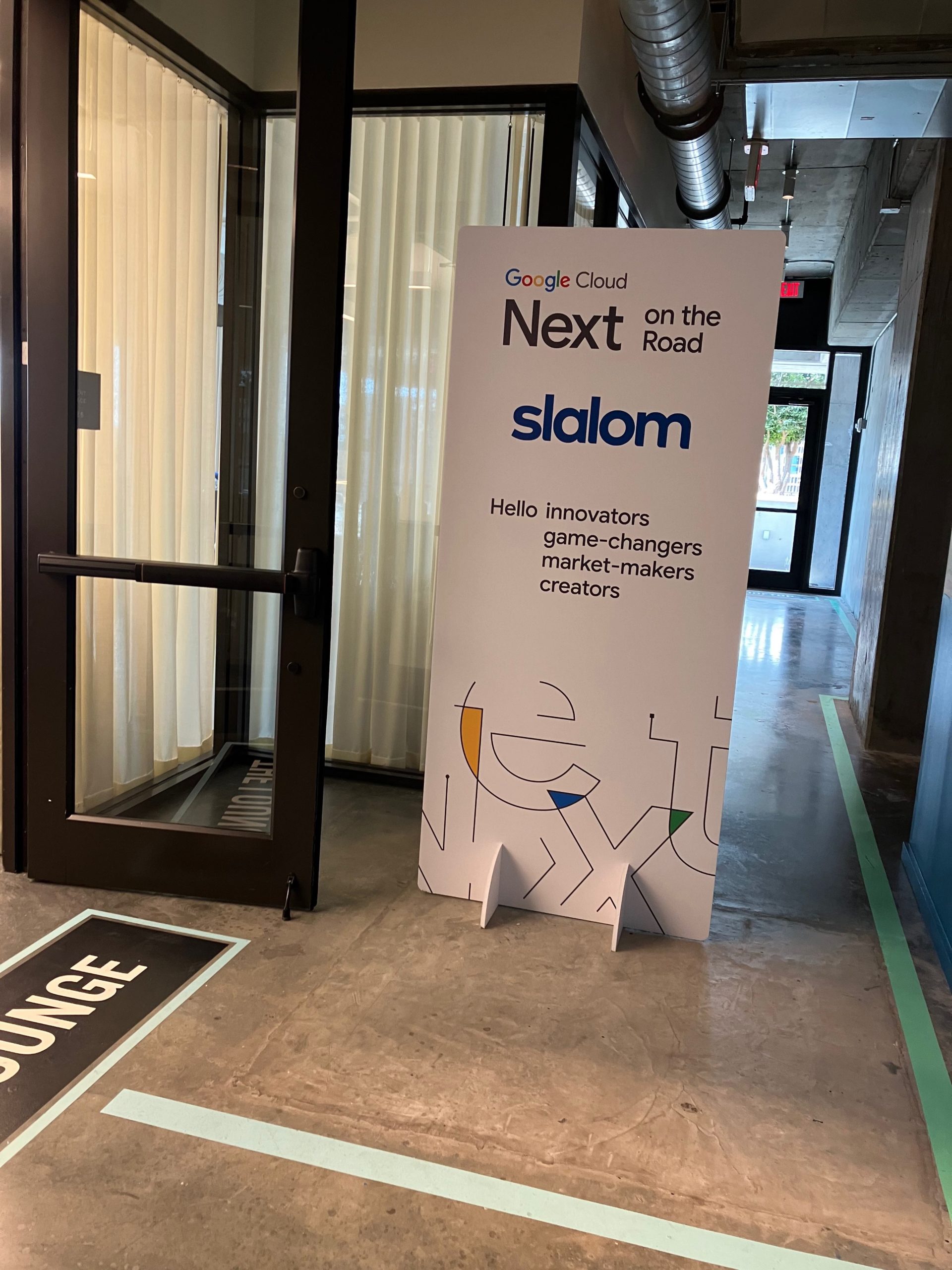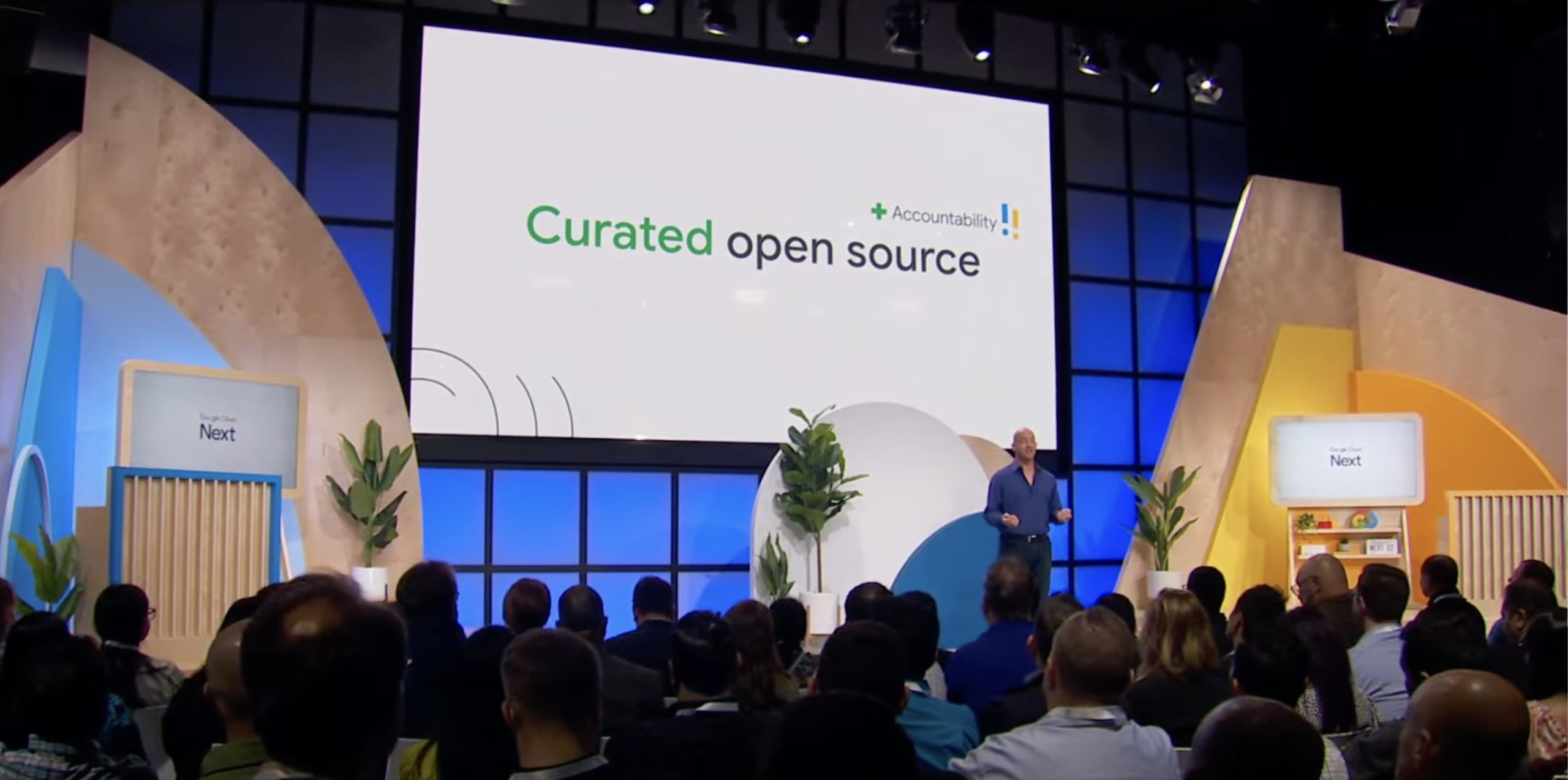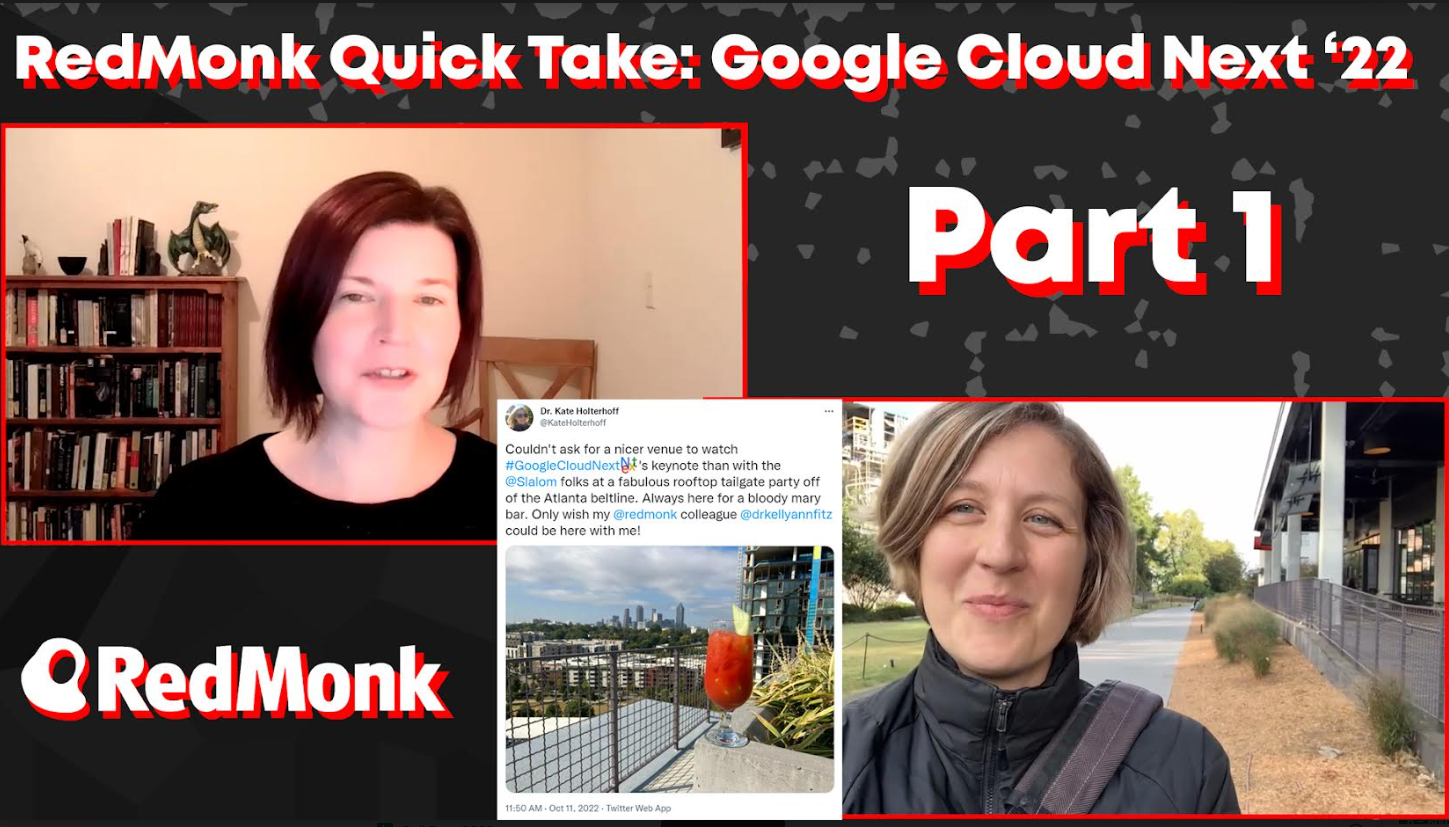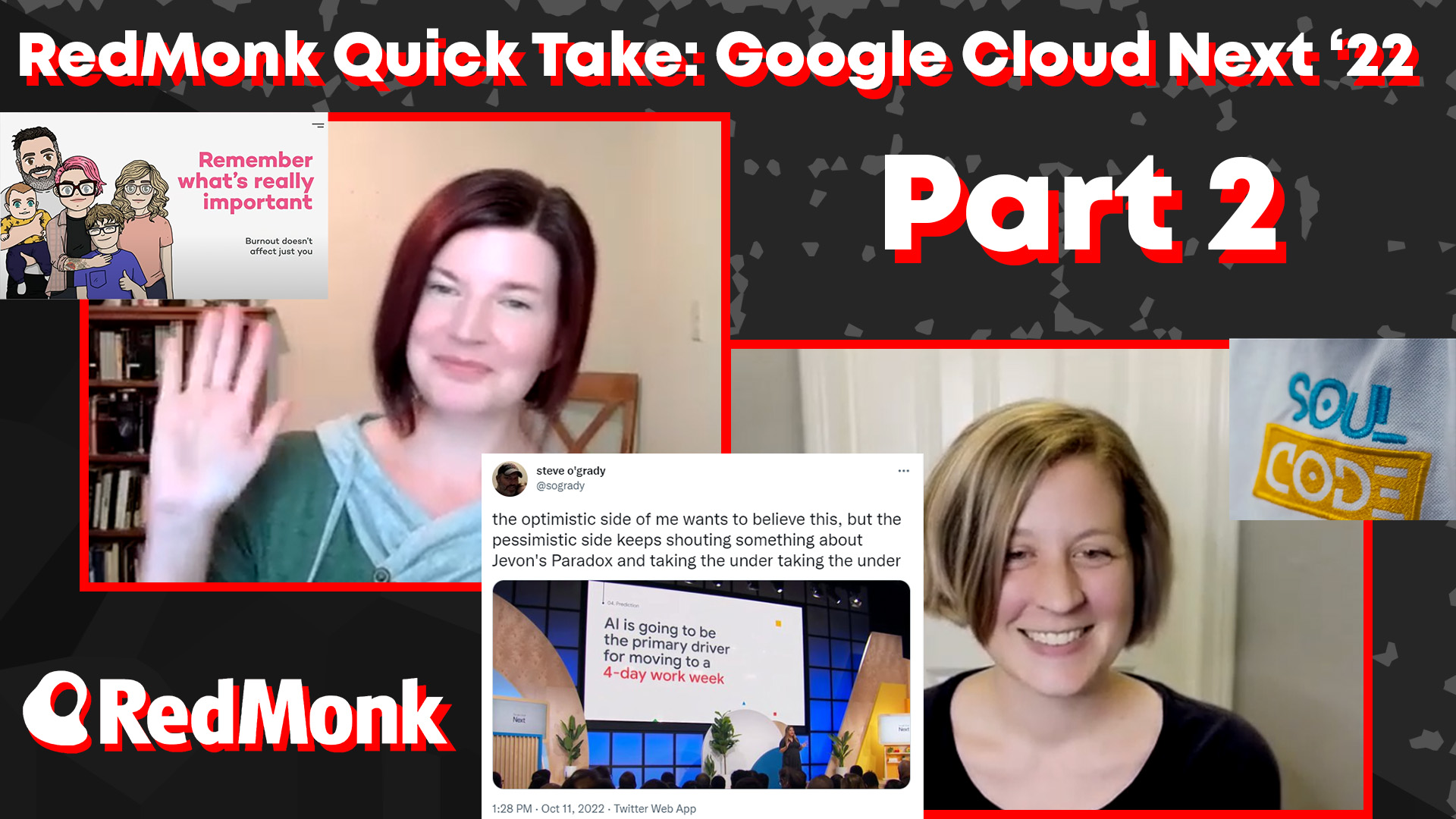In the spirit of Google Next 2022’s hybrid approach, my colleague and senior analyst Kelly Fitzpatrick and I collaborated on two videos to shake up our typical Quick Take format. First, we framed our videos as conversations in order to take advantage of our unique experiences. Second, I left (busted out?) of my home office to film part of this video on the Atlanta Beltline while walking to a Next on the Road keynote watch party hosted by Slalom.
RedMonk Quick Take: Google Cloud Next ’22 (Part 1)
Here at RedMonk, analysts record Quick Take videos to capture our thoughts in a pithy format that we can produce and share with more immediacy than our longer format video series offerings. The RedMonk Quick Take has always been a fun and informative means to condense our ideas and impressions, but have tended to take the form of talking heads. For this video, Kelly and I adopt a playful, hybrid approach to reflect the creative ways in which Google has met the challenges of the Covid-19 pandemic, which moved so many conferences in the tech industry (including Next ‘20 and ‘21) online. In Kelly’s words:
To recap: in 2020 Google Cloud next, along with virtually every other tech event on the planet, moved to virtual formats. Because it took place at the end of 2020, Google Cloud had a lot of time to think about what type of event it wanted to deliver and put together a fully virtual event that was temporally distributed over a nine week period. In 2021, the event remained virtual, but was condensed back down to a few days. And here in 2022, with many of us willing to get on planes again, but not all of us willing or able to travel, Google Cloud Next is experimenting with a hybrid format.
Next on the Road
What did Next’s 2022 hybrid format look like in practice? For myself and others participating in Next on the Road events, it meant smaller, more intimate experiences to facilitate meeting attendees in their backyards. I summarize the type of events these Next on the Road experiences took:
So what is Next On the Road, you ask? I’m lucky enough to live in one of the bevy of locations hosting a social event in conjunction with the conference. In addition to Atlanta some other cities getting in on the action include Austin, New York, Miami and Toronto. Not all of these Next On the Road events are keynote watch parties. Some lucky attendees in Miami, for instance, are being treated to an executive cruise on a chartered yacht where guests are being treated to lunch and cocktails.
Although Next on the Road featured many virtual components (namely live streaming watch parties), by fostering smaller gatherings Next allowed for more meaningful engagement with participants. My attendance at the Slalom event was a fun way to watch Thomas Kurian, CEO at Google Cloud, deliver his keynote. This tailgate themed event (lots of football jerseys) featured a buffet and open Bloody Mary bar at a rooftop event space. All of this was certainly nice, but the best part of Next on the Road in my opinion was that it facilitated networking. I met several representatives from the Google team such as Claybourne Barrineau, Customer Engineer working on Big Data at Google, and Jason Price, Account Executive at Google, well as numerous folks from Slalom. As networking and fancy food and drinks are some of the best draws for conferences, Next on the Road provided me with a convincing imitation of a real conference experience—all without having to fly out of Atlanta!

RedMonk Quick Take: Google Cloud Next ’22 (Part 2)
There’s so much to unpack from this year’s Next conference, so Kelly and I set aside some time to chat about our biggest takeaways. After gushing about Bloody Marys and my Next on the Road swag, we dug into our impressions, which I summarize below.
5 Takeaways from Google Next 2022
1) Google’s commitment to AI got top billing. Kelly notes the impressive improvements to Google’s Translation Hub, which added 24 new languages to Google Translate (135 languages total). Google Translate uses Google Cloud AI technologies including Neural Machine Translation and AutoML to power this product, which is successfully opening up communication particularly among enterprise customers to a more globally inclusive community of users. As Kelly explains:
And for me, the Translation Hub, I think that is legit awesome technology and I thought it was really great to see that spoken about, not only in the introductory keynote, but we got a demo of it later on in that initial three hour keynote segment as well.
2) Inclusion. Google Cloud’s vision for the future is inclusive, and nowhere was this objective more clear than in the Developer Keynote. Emcee Jeanine Banks, VP & GM Developer X and head of DevRel, set the stage for this theme by noting the importance of Neurodiversity and upskilling. As I explain:
[Jeanine Banks] began by talking about upskilling and ensuring that more developers can be included in that conversation, not only by talking about neurodiversity, but also by including a really engaging story with a Brazilian code camp called Soul Code and one of the graduates named Patricia, who is a mother of three and has really overcome some challenges, but through Google Cloud and their certification program was able to overcome them and become a certified engineer and has really excelled and succeeded professionally with the help of Google and their products.
3) Developer Centeredness. As the prominence of the Developer Keynote suggests (it immediately followed Kurian’s keynote), Google Cloud has taken pains to put the developer experience front-and-center. One of the most engaging ways the conference organizers highlighted the voices of its developer community is through developer predictions. Each of the 10 participants in the Developer Keynote offered a prediction for 2025, and explained how Google products would factor into achieving each. Kelly points out how impressed she was with the prediction made by Eric Brewer, VP Infrastructure & Google Fellow that “by 2025 4 out of 5 enterprise engineers will use some form of curated open source.”
I also really like the curated open source prediction. This is definitely something [of importance as] almost everyone is running open source. So getting around [to] how do we use it in a more effective, smart, and supported way. Where we have seen folks like Tidelift already really concerned about this and trying to figure out how to better support open source maintainers and make open source better for consumers. But to see that on the main stage for Google Cloud was also really, really cool.

All of these predictions were noteworthy in different ways, as our video takes up in greater detail. But overall the event’s emphasis on developers it truly noteworthy, as I suggest in my final thoughts for this Quick Take recording:
I was really impressed by the fact that Google put the developers first. There was a lot of care and thoughtfulness that pervaded all of the talks and really emphasized the fact that the engineers are having this position, this pride of place in the organization. And all of that really came through.
4) Repercussions of the Covid-19 pandemic: The Great Resignation, Work-life balance, Burnout. Looming over Next continues to be the ongoing challenges posed by the Covid-19 pandemic. While folks are getting out more and more, and public masking is becoming increasingly rare, the pandemic’s ripples continue. There is a reason Google decided not to return to business as usual for Next, but has instead opted for a hybrid approach. Ashley Willis’s keynote on the subject of Burnout advanced Next’s objective of meeting practitioners where they are by empathizing with their experience. In Kelly’s words:
[Burnout] is a topic that we have heard about … throughout the pandemic, and I think in some senses some people feel like, okay, this is done. We’re over this. But [Willis’s] talk was so informational. It was great in terms of: How do you recognize burnout? How long does it take to get over burnout? What are some things that individuals can do to avoid or recover from burnout? And most importantly, what can managers do to help their folks not get burnt out? Which I think is amazing because, if I’m a manager, I have to deal with my own burnout and then the burnout of all of the people that I am managing. So this, again, for me, was probably the most important talk of the entire event and seeing Google Cloud giving this a half hour of its keynote real estate, like kudos, kudos, Google. Good job with this.
5) Bonus takeaways. In an attempt to keep both Quick Takes as concise as possible, not all of Kelly and my thoughts made it into the videos. A few other items of note:
- I was interested by Google Cloud’s efforts to unify transactional and analytical data
- Kelly was impressed by the emphasis on customers during the event, both during the introductory keynote and in the hour-long keynote session on customer stories
- Both analysts took note of the Software Delivery Shield announcements, as software supply chain security becomes an increasingly hot topic
Did you attend Google Next 2022? If so, share your biggest takeaways here or on Twitter.
YouTube Links
Disclaimer: Google Cloud and Tidelift are RedMonk clients, and these Quick Take videos are sponsored by Google Cloud.


Upskilling’s Greenfield Field – TOP Show HN says:
February 5, 2023 at 2:06 am
[…] section from Google Cloud Next 2022 pertaining to SoulCode Academy is in particular transferring (scrutinize my discussion with KellyAnne about it). Nonetheless, it advances the parable that certification===job. Certain, some folk are ready to […]